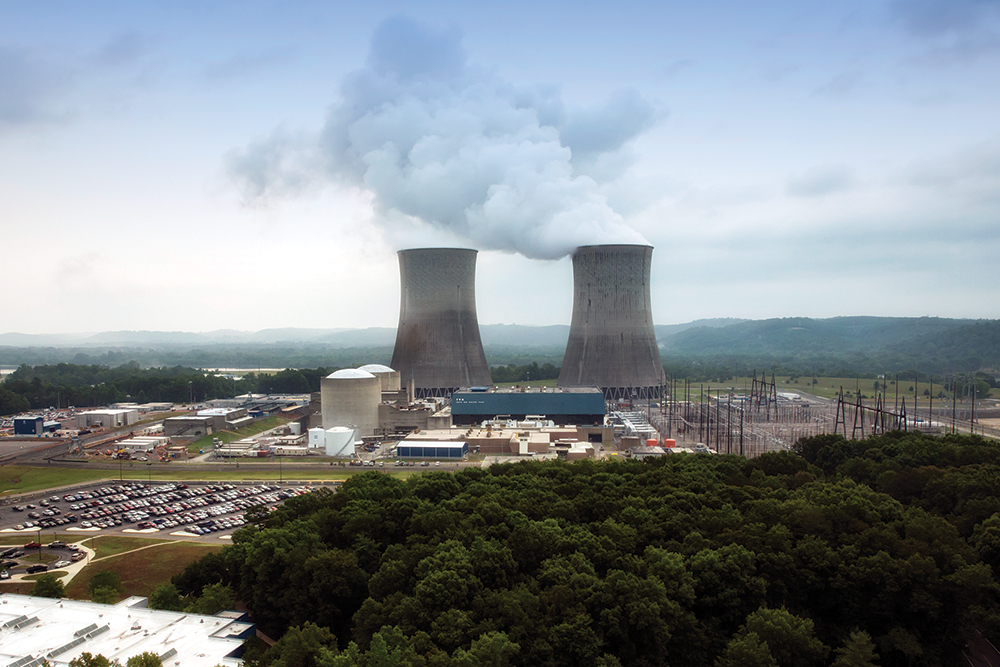
Will the controversial source of electricity grow, shrink or stay about the same?
By Paul Wesslund
As energy headlines scream about a war on coal, fracking that’s pumping up a lot of low-priced natural gas and the rise of wind and solar power, one form of electric generation quietly continues to keep the lights on.
About one in every five electrons running through the wires in your home comes from a nuclear power plant. Even if you already knew that, you probably haven’t given it much thought lately. There are good reasons for that lack of attention: Nuclear power has been reliable and affordable.
Nuclear became one of our main fuels for electricity by overcoming huge obstacles to a pretty simple idea—heating water into steam that turns a turbine that generates electricity, similar to the way a coal-burning power plant works. The difference is that in a nuclear power plant, the fuel is uranium, and it doesn’t burn. Instead, the heat is generated by splitting the uranium atoms, releasing large amounts of energy from very small amounts of fuel.
Electric co-ops support nuclear power
But the details are hugely complicated. Highly advanced physics and engineering were needed to build the first nuclear plants in the 1950s. And the dangers of radioactivity called for extreme safety measures. Regulating the technically complex industry falls to the Nuclear Regulatory Commission (NRC), an independent agency of the federal government, and its nearly 4,000 employees and $1 billion budget.
In the U.S., 60 nuclear power plants operate 100 nuclear reactors (some plant sites have more than one reactor) in 30 states. In addition to regulation by the NRC, those plants operate under a variety of agreements with groups as varied as the Department of Homeland Security, state and local governments, emergency responders and academic researchers.
The regulation and cooperative agreements are called for because of the high-stakes concerns with nuclear power. In addition to the health and safety concerns, cybersecurity and safeguards against possible terrorism are regularly reviewed.
Do all these protective efforts work? The fact that nuclear power provides one-fifth of the electricity in the U.S. offers evidence of its acceptance.
Electric co-ops as a national group see nuclear power as a valuable part of the mix of fuels that make our electricity. An official membership resolution of the National Rural Electric Cooperative Association (NRECA) calls for “legislative and regulatory initiatives to support the continuation and expansion of nuclear power.”
Dale Bradshaw describes why electric co-ops see nuclear power as a good way to generate electricity. Bradshaw is CEO of Electrivation LLC, a firm that consults on power generation and delivery with groups that include NRECA.
“Nuclear power is safe and emits no carbon dioxide,” he says, noting the industry’s safety and security systems and the lack of greenhouse gas. Bradshaw also sees advantages of nuclear power over the increasingly popular renewable energies of wind and solar, since solar doesn’t produce energy at night and wind doesn’t work in calm weather.
“We need nuclear for reliability; it runs around the clock,” he says, adding, “existing nuclear reactors are basically cost competitive—it’s a low-cost resource.”
A bright future for nuclear power
So if nuclear power is so great, why isn’t it used for more than 20 percent of our electricity?
The need for fuel diversity is one reason, but Bradshaw says growth in nuclear power use is being restricted by a unique combination of forces. The drilling boom of the past several years has dramatically lowered natural gas prices, and various government subsidies have reduced the costs of wind and solar. Electricity markets base energy prices on the lowest cost producers and because of the recent low cost of natural gas and continued subsidies for renewables, prices are too low to support the building of new nuclear units. When utilities make their buying decisions, nuclear power often is not the preferred choice these days.
But Bradshaw sees a potentially bright future for nuclear power, referring to today’s market forces as “a short-term problem.” He notes that natural gas prices have started rising, and that the tax breaks keeping wind and solar costs low will expire in a few years. He adds that researchers are developing nuclear plant designs that will be even safer, lower in cost and will extend the life of existing nuclear fuel.
“There are advanced reactor technologies in the early stages of development that might allow us in the next 20 years to build these technologies for 25 percent of the cost of existing nuclear plants,” says Bradshaw. “Advanced nuclear will more efficiently use the fuel and become essentially sustainable with thousands of years of fuel supply, and be more price competitive in the market.”
Paul Wesslund writes on cooperative issues for the National Rural Electric Cooperative Association, the Arlington, Va.-based service arm of the nation’s 900-plus consumer-owned, not-for-profit electric cooperatives.




